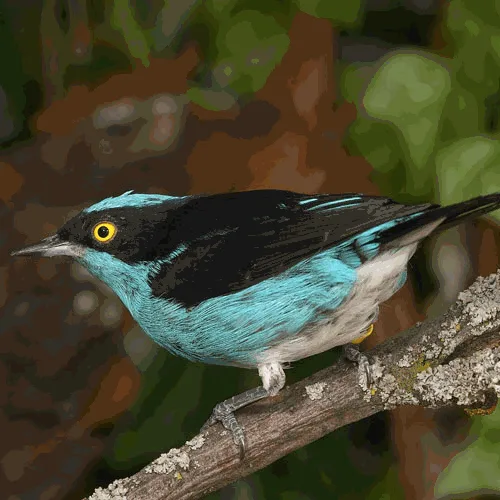 Black-faced Dacnis [order] Passeriformes | [family] Thraupidae | [latin] Dacnis lineata | [UK] Black-faced Dacnis | [FR] Dacnis a coiffe bleue | [DE] Maskenpitpit | [ES] Mielero de Cara Negra | [IT] Dacne faccianera | [NL] Zwartmasker-pitpit SubspeciesMonotypic species Physical charateristicsBoth male and female have a yellow iris. The male is turquoise blue with black lores, mask, wings and tail. The centre of the belly and crissum are white as are the underwing coverts which you can see just showing through at the front of the wing. The female is much less colourful being largely brown-olive above and pale grey below Listen to the sound of Black-faced Dacnis [audio:http://www.aviflevoland.nl/sounddb/B/Black-faced Dacnis.mp3]
RangeIt is found in Bolivia, Brazil, Colombia, Ecuador, French Guiana, Guyana, Peru, Suriname, and Venezuela. The Black-faced Dacnis is distributed throughout most of the Amazon Basin and the Guianas with two disjunct populations in central Colombia and western Ecuador. HabitatIts natural habitats are subtropical or tropical moist lowland forests, subtropical or tropical swamps, and heavily degraded former forest. It is found in Bolivia, Brazil, Colombia, Ecuador, French Guiana, Guyana, Peru, Suriname, and Venezuela. Its natural habitats are subtropical or tropical moist lowland forests, swamps, and heavily degraded former forest. Commonly resides lowlands to 1350 m. ReproductionLittle is known about reproduction of this species. The family Thraupidae has general characteristic regarding reproduction. The clutch size is 3-5 eggs. The female incubates the eggs and builds the nest, but the male may feed the female while she incubates. Both sexes feed the young. Feeding habitsThe Black-faced Dacnis feeds off fruits, berries, seeds and insects. It will commonly feeds 10 to 50 meters off ground in crown of trees, but occasionally descends to fruiting shrubs. It searches for insects on tree branches. ConservationThis species has a large range, with an estimated global Extent of Occurrence of 5,400,000 km². The global population size has not been quantified, but it is believed to be large as the species is described as ‘frequent’ in at least parts of its range (Stotz et al. 1996). Global population trends have not been quantified, but the species is not believed to approach the thresholds for the population decline criterion of the IUCN Red List (i.e. declining more than 30% in ten years or three generations). For these reasons, the species is evaluated as Least Concern.  MigrationSedentary throughout range Distribution map |
]]>
